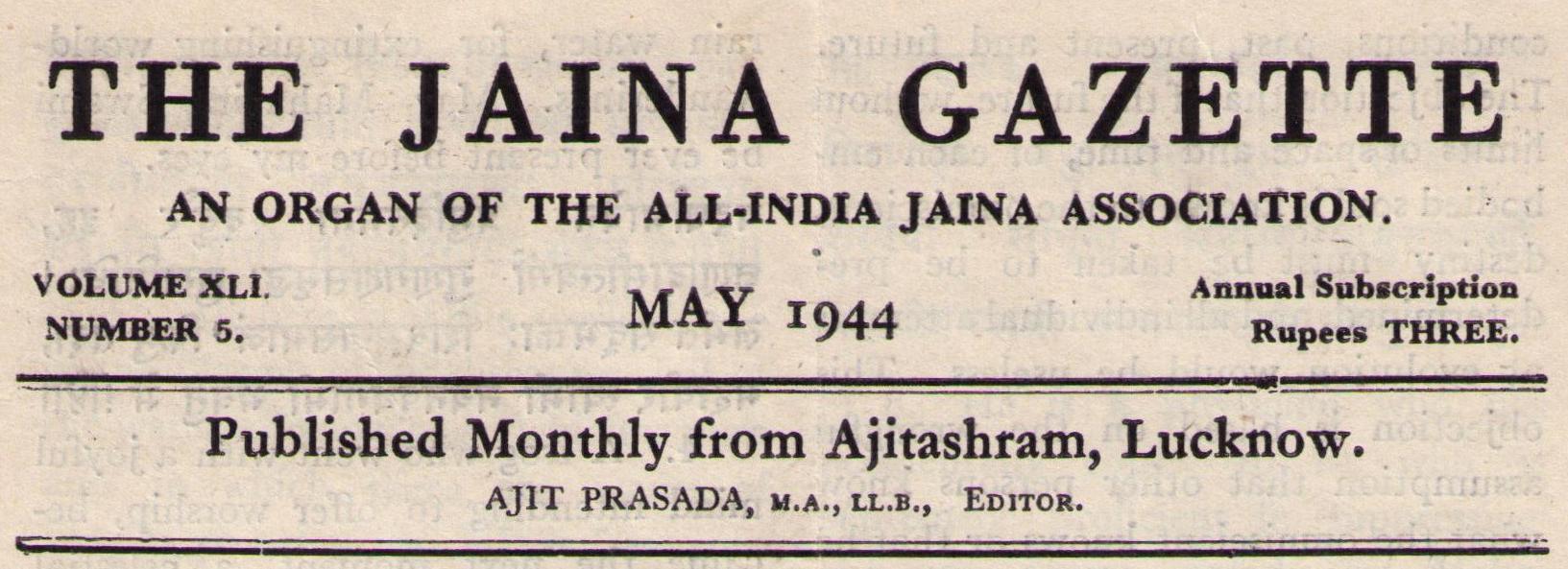
The paper was first published in May, 1944 in The Jaina Gazette, Vol. XLI (No. 5), pp. 67-70. For the online reissue some miniature paintings of Jaina cosmology from ancient manuscripts were added.
The Physical Universe in Jainism
Jainism accepts the world of sense perceptions as real, and makes all knowledge based on sense perception relative to time and space. The only absolute knowledge is that of the Kevalin, and this from the point of view of ultimate reality is confined to the self. The Kevalin in fact represents a state of being in which the logical or conventional distinction between knowledge, the knower and the knowable, between subject and object ceases, and the self is all in all. On the lower planes, however, these distinctions obtain, and reality as a whole is supposed to be mirrored in the omniscient mind, but without any inclination on its part.
This being the basic position, it is clear that the doctrine is compatible with change and advance in scientific knowledge; and no attempt need be made to derive prestige or authority for Jainism by establishing similarity between the physical theories of the Jains and those of modern science. In fact as Jainism would not be prepared to rise or fall by the changing verdict of science, it is best to let the doctrine stand by itself for what it is worth. All the same, a comparison of old ideas with new ones has a fascination for any one interested in the history of human thought and this paper is written purely from this point of view.
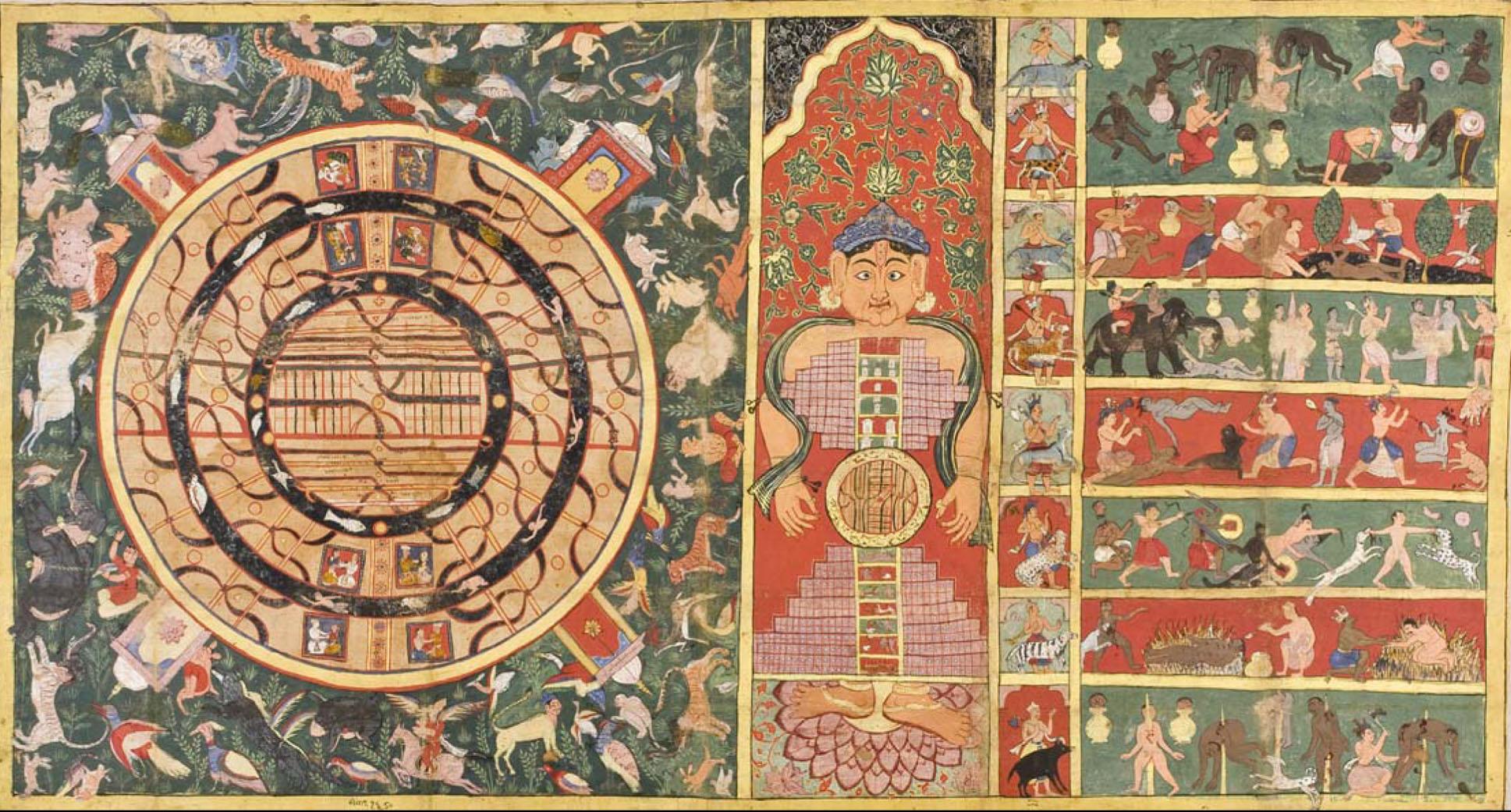
Diagrams of the Jaina universe: Two and a half continent, the universe in the shape of a person and the seven levels of hell, Gujarat (?), V.S. 1670 (1613 CE). Ink, opaque water color and gold on cloth, Catherine and Ralph Benkaim Collection.
The Jaina universe consists of six substances:
soul or the principle underlying the phenomena of life and mind,
-
matter,
-
Dharma or the medium of motion,
-
Adharma or the medium of rest,
-
space,
-
time.
(1) Soul is not recognized by science, but life and mind are. Life has a physical basis and mind is always associated with it, but it is not possible to interpret mind in terms of matter, even imaginatively. All mental states have physical counterparts, except pure consciousness, the possibility of which is questioned by some thinkers.
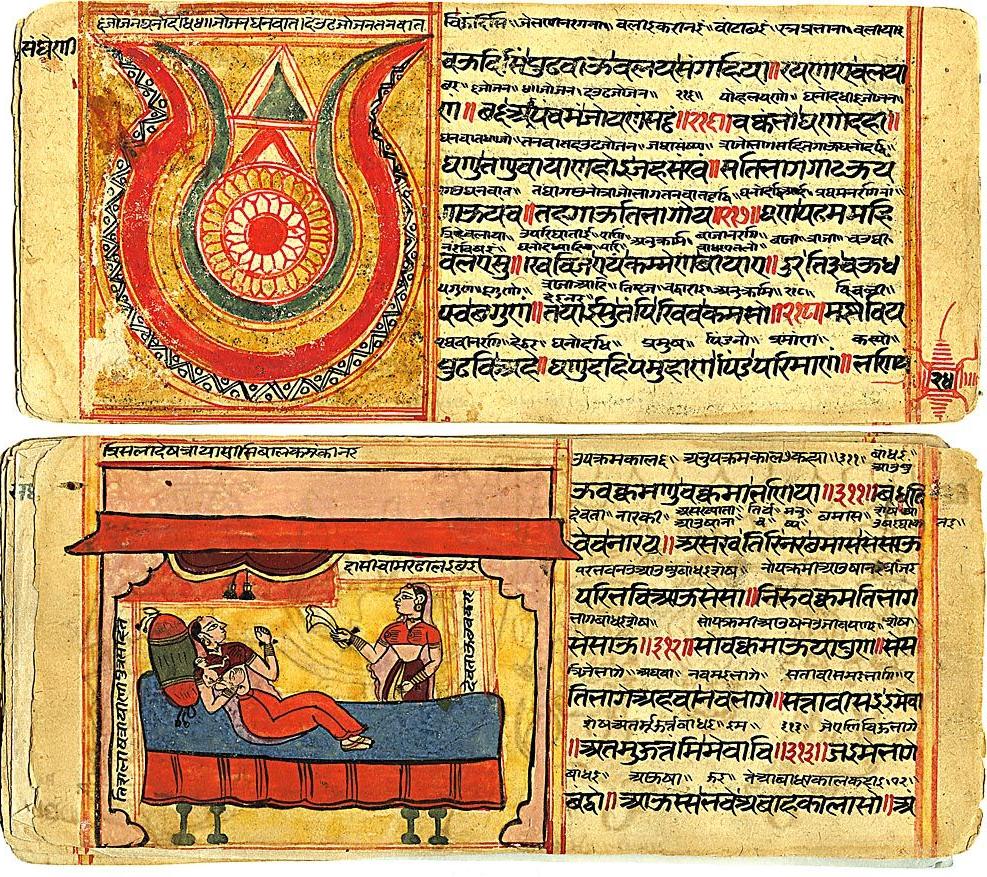
MSS. of Sankhitta sangheyani of Shrichandra. A concise compendium of cosmography, West India, c. 17th century.
Jainism definitely posits a soul and with regard to the mundane soul, its position is the same as that of science which is not concerned with anything beyond. It believes, however, in the possibility of the emancipation of the soul, in which state the soul retains only pure consciousness of all the mental states associated with the mundane soul. Other mental states are all given a physical basis, though they arise in the soul. Physical basis does not, however, mean merely physiological basis, but it also covers changes in the subtle Karmic body which goes with the soul from birth to birth. This conception is peculiar to Jainism.
(2) Matter is given by Jainism an atomic structure. Two kinds of atoms (paramānūs) are mentioned - the causal paramānū, which seems to correspond to atom proper, and the effect paramānū which would represent a molecule. These terms are, however, somewhat misleading, in that they suggest a definite theory of chemical action. In the Jaina theory, stress is laid on the general physical properties of matter and the term paramānū is generally used in the sense of a particle, which may mean an electron, a proton or even a photon as light is given a material character. A paramānū is related to space and time, in the interpretation of phenomena which can in ultimate analysis be reduced to the movements of individual paramānūs.
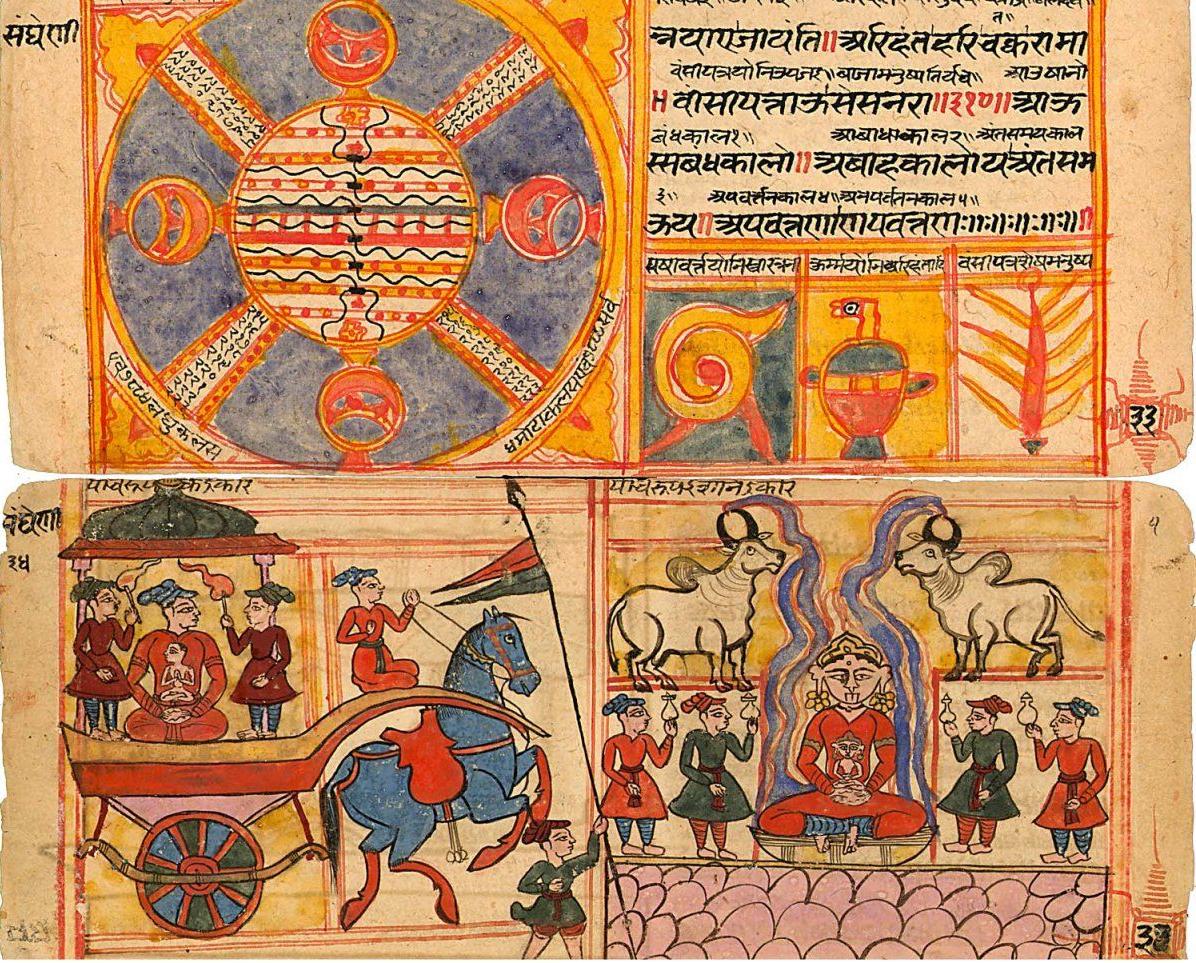
MSS. of Sankhitta sangheyani of Shrichandra. A concise compendium of cosmography, West India, c. 17th century.
Matter in all forms is endowed with souls, quite apart from and independently of any organisms that may be present in the mass. Water for instance has souls which have water itself for their bodies. The mass harboring a single soul is imperceptible by the senses.
Science does not associate mind with plants, and differentiates between organic or living matter and inorganic or dead matter. Sir J. C. Bose's researches have not convinced the scientific world, because he only obtained certain reactions from plants and even minerals, of which he gave a psychological interpretation, whereas no nervous system in plants has yet been discovered, to say nothing of minerals. But recent developments in physics relating to the study of the electron, the ultimate constituent of matter in all forms, has reached some startling conclusions. The electron individually is found in some respects not to obey physical laws, but the law of chance like an organism. The number of electrons, however, forming a mass of even microscopic size is so large that the conclusions reached by the law of chance become physical laws in actual practice. This fact lends a new significance to the Jaina theory. It is not any development of philosophy, psychology or biology that has led scientists to speculate about God and soul, but the behavior of the electron which suggests the presence of an unknown factor at work in the universe, of the order of mind.

MSS. of Sankhitta sangheyani of Shrichandra. A concise compendium of cosmography, West India, c. 17th century.
(3) Dharma, (4) Adharma and (5) Space may be considered together. Dharma and adharma render motion and rest possible by serving as media. The cause of motion, however, inheres in matter. Space accommodates all other things. All the three are real but they are incorporeal and inactive agents. Together they form a homogeneous whole. Dharma and adharma function as single entities, but space though continuous can be treated as divisible into parts, the smallest unit (pradesa), being the space occupied by aparamānū or atom. This combination fills the whole universe, which is limited; but empty space also extends beyond, and is infinite.
It will be seen that the conception of world space in Jainism is the same as in science. Dharma and adharma would correspond to ether which has been discarded by the theory of relativity. The necessary functions are according to science discharged by space itself in which the presence of matter produces certain strains. If we change the definition of space in the Jaina doctrine so as to cover the functions of dharma and adharma, the general position becomes comparable with that in science where the theory of relativity holds the field at present. This theory gives space a sort of curvature which makes it limited like the world space of Jainism. Science of course, is concerned only with world space in which phenomena take place.
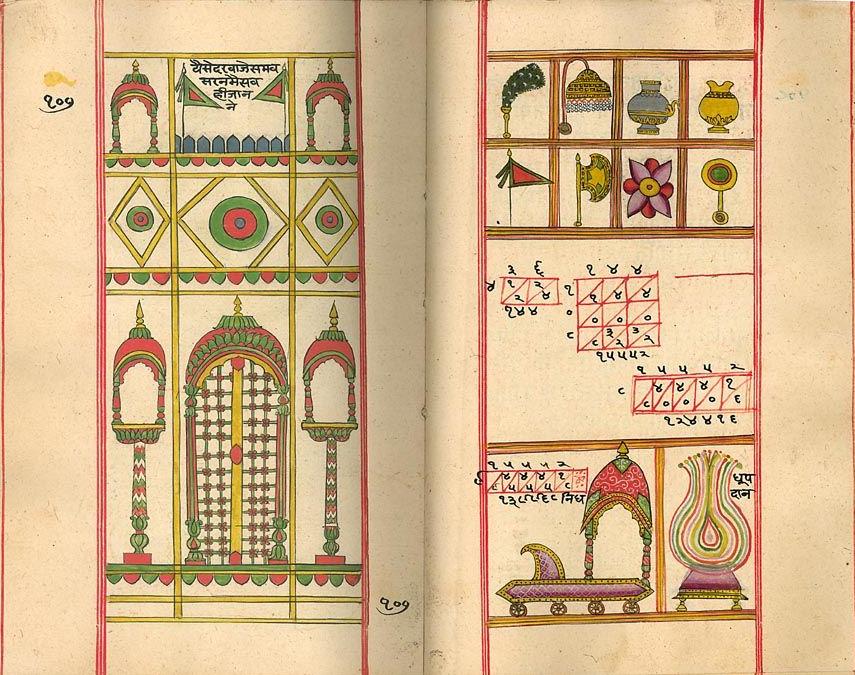
Jain cosmological text, 1826.
(6) Time is given by Jainism a most interesting structure. The conventional divisions of time into past, present and future do not apply to real time, which is divided into discrete units, kālānūs, each point of space having its own kālānū eternally functioning for it. This is rendered possible by the peculiar nature of time. One and the same kālānū represents past with regard to the particles which have passed through it, present for those passing through it now, and future for those that will do so afterwards.
We cannot say how reality is mirrored in the omniscient mind, but speaking in terms of geometry, a kālānū has to be represented by a line, and it is a line passing through only one point of a three-dimensional space. All points of space have these lines passing through them. Reality would, therefore be represented by a four dimensional magnitude, three dimensions of space and one of time. We thus get the space-time continuum to which the theory of relativity has led science, only recently. No particle is at rest in this continuum. If it does not move in space it is moving along the time-line. Every particle has its life-line drawn in this continuum and phenomena are all recorded in it. An omniscient being can see the picture as a whole. As time is infinite, we have to imagine that the time-line on reaching the end of the universe turns on itself, giving the universe an oscillating character. This is recognized in the conventional division of time into six ages moving forwards and backwards.

Jain cosmological text, 1826.
For us, limited beings as we are, it is not possible to represent reality by a model, much less by a diagram. The nearest approach, science gets is a soap-bubble with its patterns. The Jaina simile is the fruit of the emblica myrabolam with its tracery.
The resemblance between the picture drawn by Jainism and that drawn by modern science is remarkable. Jainism started with intuition and first posited an omniscient Being. The picture of reality was made compatible with this conception. The Jaina theory of knowledge clearly shows that the method adopted was the scientific as opposed to the dialectic method. Science started at the other end of the scale and studied the behavior of the electron, the ultimate constituent of matter. Step by step it was led to a point where it began to grope for an omniscient mind.
 Jagat Prasad
Jagat Prasad